What is Laminitis in Horses?
By Dr. Lydia F. Gray, posted September 2022
In simplest terms, the word “laminitis” combines the words “lamina” and “itis” and therefore literally means inflammation of the lamina. The lamina are tiny Velcro-like tissue in horse hooves that attach the inner bone to the outer hoof wall. Sometimes laminitis is called “founder”, which is a very old term relating to boats -- meaning to fall or sink down -- but this is used for severe cases where the coffin bone sinks and may come through the sole of the hoof.
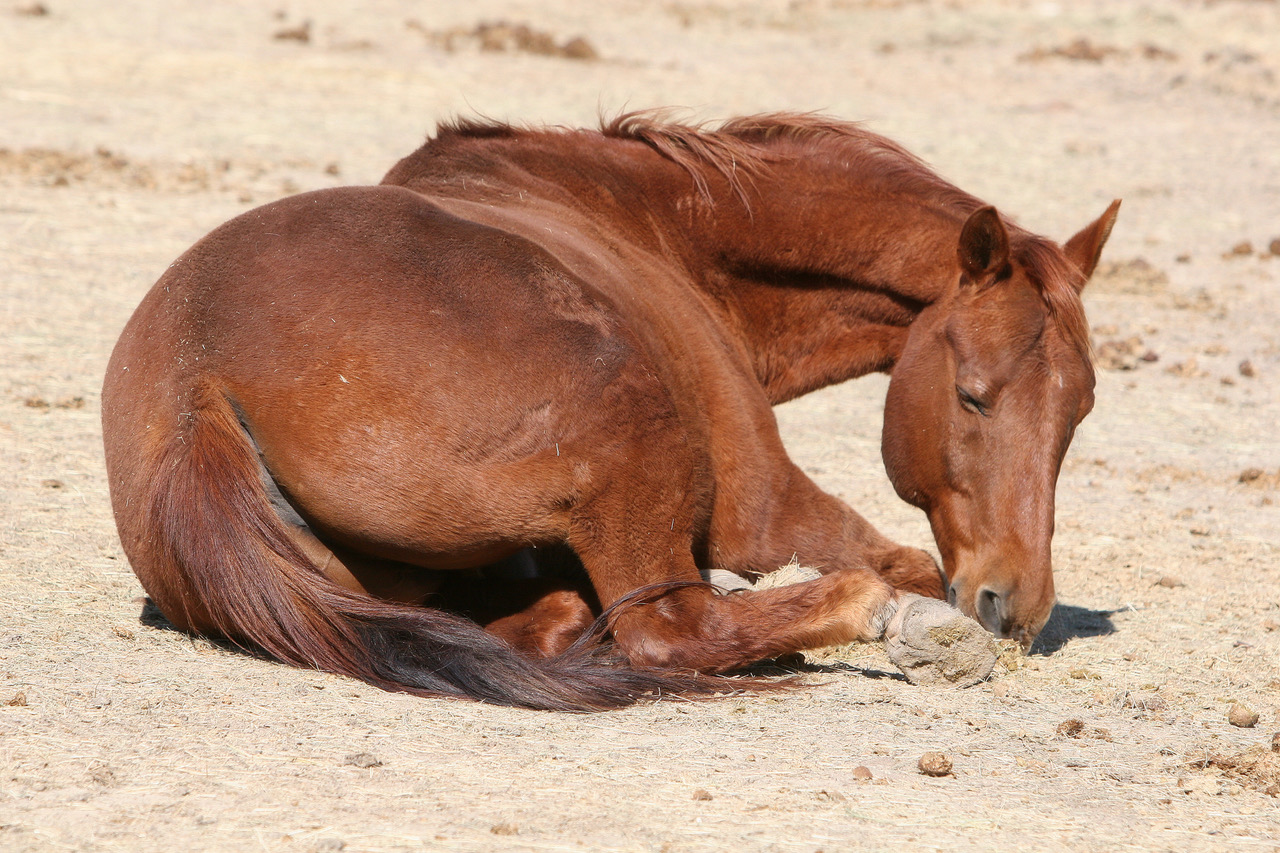
For many years, it was thought that laminitis was a result of damage to the lamina from inflammation. Inflammation is the body’s local response to an injury or infection and has five key components: heat, swelling, redness, pain, and loss of function. A sprained ankle in a person is a good example of inflammation. Given that the hoof wall is made of a hard substance that cannot swell or change color, the signs of inflammation in the horse’s feet are not as simple to detect as in a person.
Clinical signs of laminitis include:
shifting weight from one front foot to the other
painful-looking gait (often described as "walking on eggshells")
classic founder stance (leaning back so hind feet bear more weight i.e. "sawhorse stance")
warm feet, bounding digital pulses
sweating, high heart rate, high respiratory rate
reluctance to move or get up from lying down
Veterinarians and research scientists have recently learned that there’s more than one kind of laminitis, and that inflammation is not always part of the equation. Read the second article in the Laminitis series: “Laminitis Has More Than One Cause” and learn how and why horses and ponies develop this condition.
Laminitis Has More Than One Cause
By Dr. Lydia F. Gray, posted September 2022
When people think of laminitis, they probably think of a pony that was turned out onto lush spring grass too quickly. Experts now know that’s a very specific – and important -- kind of laminitis so they’ve given it a special name: pasture-associated laminitis or PAL. Because there are several teams of veterinarians and research scientists around the world studying laminitis and they’re still figuring things out, there are a couple of other names in use:
Endocrinopathic Laminitis or EL
pronounced “in-doe-crin-oe-PATH-ick”)
“endocrine” means hormones, and “pathic” means caused by
Hyperinsulinemia-Associated Laminitis or HAL
pronounced “high-per-inn-sull-inn-EE-me-uh”
“hyper” means too high, “insulin” is a hormone, and “emia” means in-the-blood
Don’t be intimidated by these long, hard-to-pronounce names! They all just mean “metabolic” laminitis. When researchers all over the world are working on the same problem separately, they tend to use Latin. This way, when they communicate with each other or publish papers, they’re talking apples to apples. Getting the terminology right, and getting it into mainstream use, is all part of the battle.
Some experts combine all three names into one: Pasture and Endocrinopathy-Associated Laminitis (PEAL). They do this to make it clear that pasture -- plus a disorder of the endocrine (hormone) system -- is what leads to laminitis in the vast majority of cases. In fact, PEAL is thought to be responsible for 90% of all laminitis cases in horses.
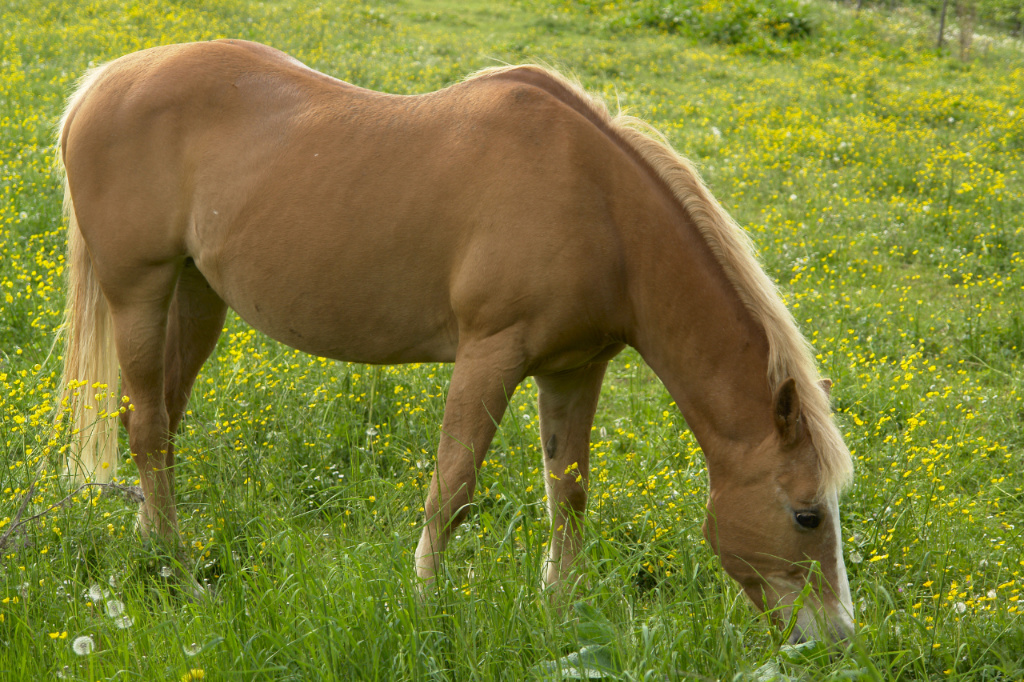
Approximately 10% of laminitis is due to another broad category: a bacterial infection or bacterial overgrowth somewhere in the body. Some vets call this Sepsis-Associated Laminitis while others call it Systemic Inflammatory Response Syndrome or SIRS. The bottom line is that toxins released from bacteria trigger an exaggerated inflammatory response from the body and together this causes damage to the lamina.
Examples of laminitis from this category include:
Grain overload
Severe diarrhea or colitis (i.e. inflammation of the colon)
Uterine infection from not passing the afterbirth, aka retained placenta
Complications from pneumonia
Toxins including black walnut, hoary alyssum, and endotoxin from fescue
Body-wide (systemic) sickness such as Strangles, Potomac Horse Fever, Lyme Disease
There is a third cause of laminitis, but it’s very rare. Some people call it Supporting-Limb Laminitis and others call it Standing-Limb Laminitis, but it occurs when one leg takes more weight temporarily because of a lameness or injury and that extra weight damages the lamina. “Road Founder” would fall in this category, as would other things that disturb the natural movement and structure of the hoof, such as a club foot or the opposite, a long toe/low heel.
Read the third article in the Laminitis series – “What do Sugars and Starches Have to do with Laminitis?” – and learn about the role of simple carbohydrates in this condition. Read the first article in the series – “What is Laminitis in Horses?”.
What do Sugars and Starches Have to do with Laminitis?
By Dr. Lydia F. Gray, posted September 2022
This third article in the Laminitis series explains the role that simple carbohydrates play in this condition. (If you haven’t already read the first two articles, “What is Laminitis in Horses” and “Laminitis Has More Than One Cause,” you may want to check them out first).
In part two, it was explained that “metabolic” laminitis is responsible for 90% of all cases of laminitis in horses. It was also pointed out that metabolic laminitis has several names in the scientific literature:
Endocrinopathic Laminitis (EL)
Hyperinsulinemia-Associated Laminitis (HAL)
Pasture and Endocrinopathy-Associated Laminitis (PEAL)
To better understand metabolic laminitis, here are some definitions of commonly used words when talking about it:
Insulin – a hormone produced by the pancreas in response to a meal that controls the amount of glucose (sugar) in the blood by moving it into cells where it can be used by the body for energy or stored for later use.
Insulin Resistance (IR) – failure of the body to respond properly to insulin
Hyperinsulinemia (HI) – abnormally high levels of insulin in the blood, which is a risk factor for laminitis
Insulin Dysregulation (ID) – a newer term used to describe horses with high levels of insulin in the blood (hyperinsulinemia), regardless of whether it’s caused by insulin resistance or another reason.
Equine Metabolic Syndrome (EMS) – a collection of risk factors such as Insulin Dysregulation, obesity, and/or “lumpy fat” that increases the risk of laminitis in horses. EMS results from the “perfect storm” of genetics and environment, in which a breed prone to this condition is fed a diet high in sugars and starches and receives little to no exercise.
Regional Adiposity – the buildup of lumpy fat (adipose tissue) in certain areas, such as the so-called “cresty neck,” also behind the shoulder, at the tailhead, above the eye, and in the sheath or mammary gland region
Cushing’s Disease/Pituitary Pars Intermedia Dysfunction (PPID) – a slowly progressive endocrine disease common in older horses, PPID happens when the hypothalamus (a part of the brain) gradually degenerates over time and stops sending signals to the pituitary gland (a different part of the brain). This leads to unchecked growth and activity of the pituitary gland causing a number of compounds to be produced, such as ACTH, which is what veterinarians measure in the blood to diagnose Cushing’s Disease. Because Cushing’s can also trigger laminitis, when horses are tested for Cushing’s they should also be tested for insulin issues. Likewise, horses with insulin issues should also be tested for Cushing’s.

Since an abnormally high level of insulin in the blood is the underlying issue for PEAL, it makes sense that preventing insulin from getting too high could be an important way to help avoid laminitis. So what causes insulin levels to increase in the first place?
Earlier, insulin was defined as a hormone that is released in response to a meal containing sugar (or starch, since this is broken down by the GI tract into simple sugars). The more sugar that is eaten, the more insulin that is produced. The less sugar that is eaten, the less sugar that is produced. People with diabetes may be familiar with this explanation because their disease has to do with high blood sugar as well. In horses then, one way to help prevent hyperinsulinemia and possibly Hyperinsulinemia-Associated Laminitis is to feed a low-sugar, low-starch diet.
That may be easier said than done, since the horse community has been conditioned to think that horses “need” grain (which is high in sugars and starches) and that our horses will love us more if we give them treats, many of which are also sugar- and starch-heavy. Then there’s the commonly held belief that ‘all horses should eat grass,’ i.e. that modern grass is the natural food of horses.
For some practical ways to lower sugar and starch intake in horses, read the fourth article in the Laminitis series: “How to Reduce Sugars and Starches in the Horse’s Diet.”
How to Reduce Sugars and Starches in the Horse’s Diet
By Dr. Lydia F. Gray, posted September 2022
This is the fourth and final article in the Laminitis series. To get the most out of it, we suggest reading the first three articles before tackling this one:
“What is Laminitis in Horses?”
“Laminitis Has More Than One Cause”
“What do Sugars and Starches Have to do with Laminitis?”
For a horse prone to or that has already had a bout of metabolic laminitis, step one is working with a veterinarian to come up with a complete plan for that individual. Proper diet, controlled exercise, plenty of turnout, and other management “best practices” should all be discussed. At the same time, owners should make sure they know how to evaluate Body Condition Score, Cresty Neck Score, and body weight.
Note that horses having an acute laminitic episode may be put on a stricter diet temporarily Exercise may also have to wait. Recovered and at-risk horses can usually be put on a less strict maintenance diet and begin a controlled workout program right away.
Often the first recommendation for reducing sugars and starches in the diet is to remove grain. This means no cereal grain (oats, corn, wheat, barley), no fortified grain in a bag, and no senior or complete feed, especially if it has molasses in it. Replace the protein, minerals, and vitamins with either a low sugar/starch ration balancer or a multi-vitamin paired with an amino acid supplement.
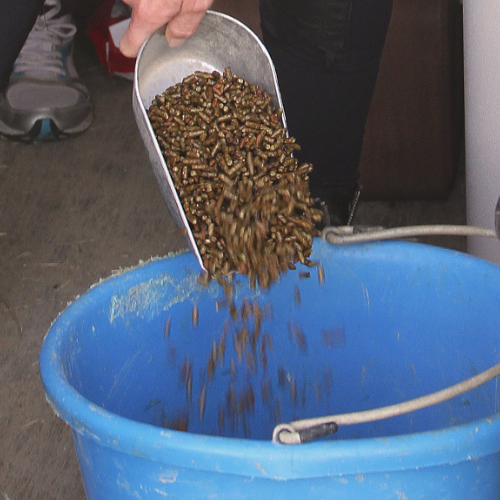
Another source of unnecessary sugars and starches is treats. Sugar cubes and peppermints are off-limits. Other treats –such as carrots and apples - should be given in moderation. Only commercial treats with guaranteed low levels of starch and sugar are appropriate. Hint: if molasses, corn, dextrose, or maltodextrin are listed on the label, chances are it’s not a low NSC product.
Focus on Forage
As important as reducing or removing grain and treats is, forage makes up the largest portion of a horse’s diet so efforts should focus on making hay and grass as safe as possible. Unfortunately, there is no safe pasture in acute laminitis situations, so horses with current sore feet need to be in a dry lot or otherwise restricted from fresh grass. Recovered and at-risk horses may be able to enjoy pasture under certain conditions: early morning, in the shade, with a muzzle. Grass that is stressed from cold temps overnight, drought, overgrazing, poor soil conditions, and other factors should not be grazed by horses prone to laminitis. Young growths of grass are particularly dangerous so spring grazing should be monitored carefully or better yet, omitted altogether.
Since hay will make up all or almost all of the diet for “carbohydrate-intolerant horses,” it’s important to understand the advice and the options for selecting and feeding hay. Most experts recommend feeding 1.5-2% of the horse’s body weight in grass hay. This works out to 15 to 20 pounds of hay spread out over the course of a day for a 1,000 pound horse. In addition, the hay should be less than 10-12% NSC when analyzed by a lab.
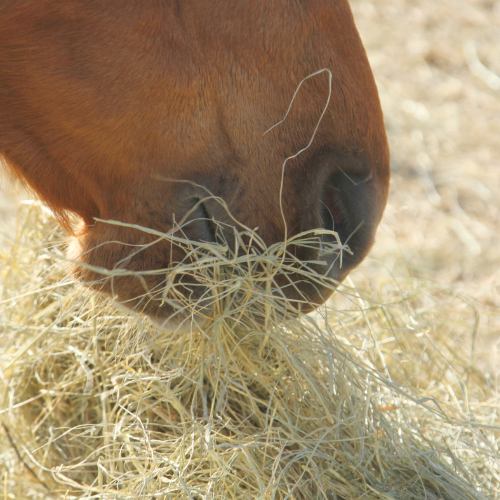
NSC stands for Non-Structural Carbohydrates and is a popular term among vets, nutritionists, farriers, and horse owners. However, it’s one of those terms that’s not quite used 100% accurately.
To set the record straight, here are the facts:
Another name for sugars in hay is ESC or Ethanol-Soluble Carbohydrates.
The combination of sugars (ESC) and fructans (a specific type of sugar), is called WSC or Water-Soluble Carbohydrates.
When you combine WSC with fructans, you get NSC, or Non-Structural Carbohydrates .
However, fructans are unlikely to cause laminitis, so we only really need to talk about the sugars and starches in hay, or ESC plus starch.
Unfortunately, neither “ESC plus starch” and “sugars and starches” roll off the tongue like “NSC,” which is probably why “NSC” stuck as the preferred term.
Here’s the problem: hay that would be perfectly fine for a carbohydrate-intolerant horse is labeled “unsafe” because the NSC % is used as a threshold and not the more correct “ESC plus starch” figures
The sugar and starch levels in hay depend on many factors, such as the species of hay (timothy, orchardgrass, brome, coastal Bermuda, fescue, others), the maturity at cutting, how long it dried in the field before baling, and even the time of day it was cut.
One way to make sure that forage is low sugar/starch at each and every feeding is to buy chopped, cubed, or pelleted hay in a bag with guaranteed maximum levels. While buying bags of forage can be pricey – and may not be available in all parts of the country – it does assure that the diet doesn’t change for horses at high risk of laminitis. This is especially important in the fall when horses with endocrine and metabolic disorders experience seasonal issues.
The best and only way to know how much sugars and starches are in hay is to have it analyzed. If it’s not possible to find hay that is naturally less than 10-12% NSC, one option is to soak the hay in water to reduce the soluble carbohydrates. A team of scientists from the University of Minnesota showed that soaking orchardgrass hay in warm or cold water for 15, 30, or 60 minutes lowered the levels of sugars and starches down into the range recommended for horses with laminitis (Martinson, 2012). This traditionally wet, messy, and labor-intensive process is becoming more reliable and convenient with modern hay soaking units where the soak and drain times can be programmed to prevent over or under soaking.
Series Summary
Laminitis is a serious hoof condition in horses that veterinarians and researchers are learning more about every day. This long-standing term is based on the thinking that inflammation plays a key role in lamina damage. However, the vast majority (90%) of episodes are due to the combination of the hormone insulin, a high sugar and starch diet, and the lack of exercise in horses and ponies whose genes put them at-risk.
With current research linking high blood levels of insulin (hyperinsulinemia) to laminitis, there are now practical ways to help prevent horses from developing this potentially career-ending and life-threatening condition. The sugars and starches can be reduced in the diet by soaking hay, limiting grass, and not feeding grain. In horses that are sound, exercise can be added or increased. A horse or pony’s body condition score, cresty neck score, and body weight can be regularly assessed. And owners can work with their veterinarian to monitor blood insulin and glucose levels as well as the presence of other diseases and conditions that may complicate the situation. Laminitis will probably always be around, but now science has given owners a better understanding of what puts their horses at risk and practical methods to reduce the threat.
Insulin Resistance
By Dr. Lydia F. Gray, posted October 2022
What is EMS and IR in horses?
Equine Metabolic Syndrome (EMS) is a condition in horses having to do with 1) insulin malfunction, 2) the presence of fat pads, and 3) a reduced ability to lose weight. These three risk factors make horses and ponies more prone to laminitis.
There are two types of insulin malfunction. One is insulin resistance (IR) and the other is hyperinsulinemia (HI). Insulin resistance is a failure of the body to respond properly to insulin. Hyperinsulinemia means high levels of insulin in the blood. Insulin is a hormone released from the pancreas after a meal, depending on how much sugar was eaten. Insulin helps digested sugar circulating in the blood (glucose) get inside cells so it can be used for energy or stored for later.
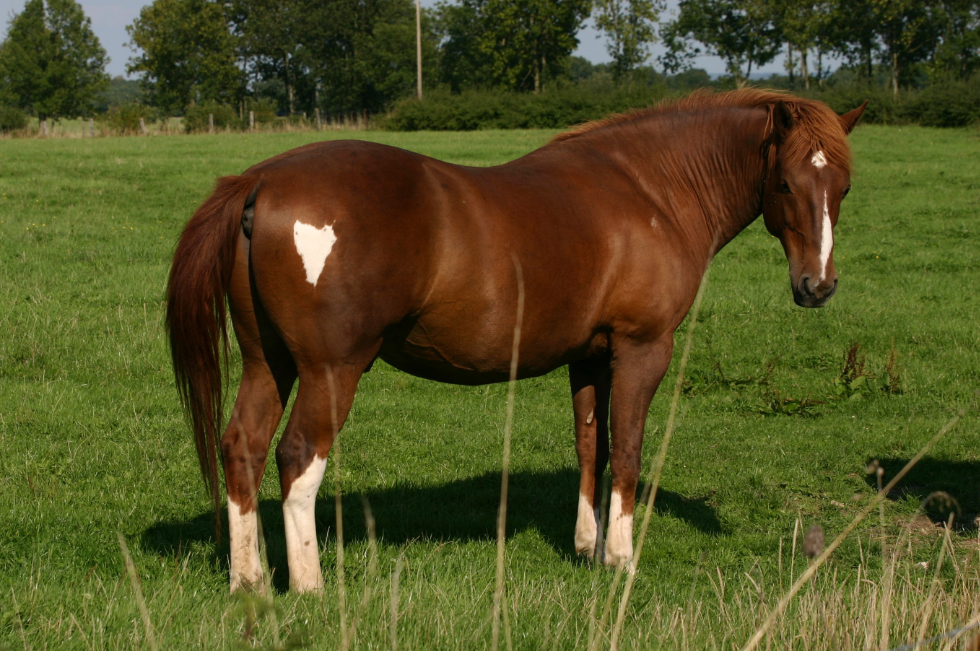
The second EMS risk factor is the presence of fat pads also called “regional adiposity.” These pockets of fat are commonly seen in the crest of the neck, at the tailhead and across the rump, behind the shoulder, above the eyes and in the sheath or mammary gland.
Owners of EMS horses commonly report their horses have a reduced ability to lose weight, the third risk factor for laminitis. They describe their horses as gaining weight on air often leading to the nickname “air ferns.” While it is most common for EMS horses to be overweight or obese, they don’t have to be. Veterinarians and nutritionists measure the amount of fat cover on a horse with the Body Condition Scoring (BCS) Scale, which ranges from 1 (extremely thin) to 9 (extremely fat). Overweight horses are in the 6 to 7 range and obese horses are in the 8 to 9 range. Ideal is considered a 5.
What causes EMS and IR in horses?
There is no one, single cause for Equine Metabolic Syndrome. Instead, the combination of genetics and environment (diet and exercise) are what puts a horse or pony at higher risk for laminitis. Certain breeds are known to have the so-called “thrifty gene,” including:
Ponies
Spanish breeds (e.g. Andalusians)
Gaited breeds (e.g. Saddlebreds, Paso Finos)
Morgans
Minis
Warmbloods
Possibly donkeys (List courtesy of The Equine Endocrinology Group)
For these at-risk breeds, it doesn’t take much inappropriate feeding and underworking to tip them into Equine Metabolic Syndrome. They’re basically “sitting ducks” when it comes to laminitis. This doesn’t mean other breeds are spared, just that it takes more high sugar/starch grain, pasture, and hay – and more stall time – to trigger the gene.
How do I know if my horse has EMS or IR?
Unfortunately, many horses are not diagnosed with Equine Metabolic Syndrome until they already have laminitis. Early signs and symptoms all owners should be looking for (but especially in the breeds listed above) include:
Obesity
Gaining weight on very little food
Reduced ability to lose weight
Fat pads (neck, shoulder, tailhead and rump, above the eyes)
Subtle lameness
Infertility
Sheath or mammary gland swelling
Any horse with these signs should be seen by a veterinarian. During the visit, the vet will perform a physical exam and take a complete history. Depending on the situation, they may perform baseline bloodwork and take x-rays of the feet. They may also test for the separate but related condition Cushing’s Disease or PPID (Pituitary Pars Intermedia Dysfunction). These tests will help your veterinarian assess your horse’s overall health and figure out if there are already signs of laminitis.
There are two “dynamic” tests for EMS. A dynamic test is when the veterinarian gives the horse a substance and then draws blood after a period time to measure the horse’s response to it. One is the Oral Sugar Test (OST) and the other is the Insulin Tolerance Test (ITT). The result of either of these dynamic tests helps the vet diagnose insulin resistance and/or hyperinsulinemia, confirming that the horse has Equine Metabolic Syndrome. If there are concerns about administering the dynamic tests, your veterinarian can draw a blood sample to look at baseline insulin levels. Ideally, owners and vets work together to determine the best method of diagnosing EMS in each individual horse.
How do I control EMS and IR in my horse?
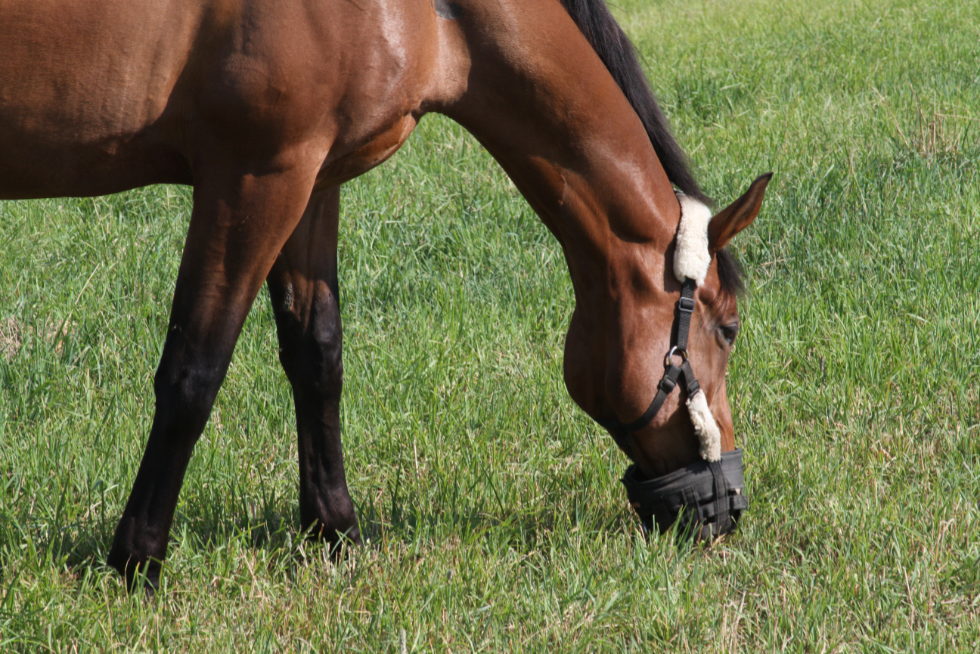
Equine Metabolic Syndrome cannot be “cured,” but it can be managed with a low sugar/starch diet and exercise. The veterinarian will put obese horses on a very restrictive diet until they lose weight and are less of a laminitis risk. This means no grazing, no grain, and only 1.5% of their current body weight in low sugar/starch hay (i.e. less than 10-12% NSC or Non-Structural Carbohydrates). Once the horse has lost weight, the diet can be less restrictive (for example, grazing with a muzzle). If the horse does not lose weight, the vet may prescribe medication. During this weight loss period, it is very important for owners to stay in close contact with their veterinarian so the horse loses weight at a safe, controlled rate.
Ideally, the hay is analyzed for sugar/starch content. Since that’s not always possible, experts recommend soaking hay in cold water for 60 minutes to reduce the NSC level. Hay soaking has also been shown to reduce calories and promote weight loss1. Feeding a low sugar/starch ration balancer or multi-vitamin/mineral helps make sure the horse still gets his daily nutrients.
Studies show exercise improves insulin resistance and promotes weight loss in horses. However, horses with active laminitis or still recovering should not be worked until they are sound and the veterinarian gives the okay. The vet will also recommend the best exercise program for the individual horse depending on their soundness, fitness, and other factors. The important thing is to start gradually -- a few minutes at a walk – and slowly build up to trotting and cantering for longer and longer time.
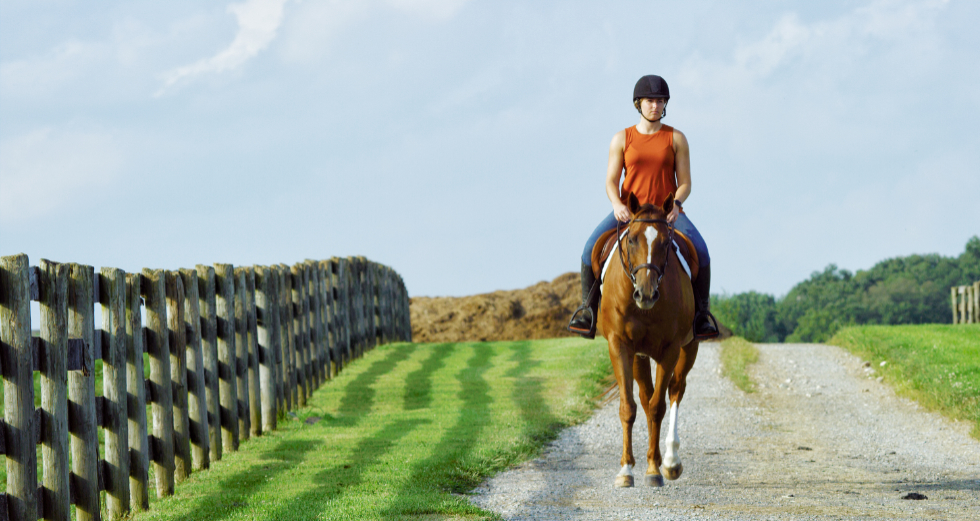
Equine Metabolic Syndrome is a manageable condition in horses that doesn’t have to end in laminitis. An honest evaluation of the horse’s body condition score, attention to diet, and proper exercise can help prevent this potentially career-ending condition.
1 Considerations for the use of restricted, soaked grass hay diets to promote weight loss in the management of equine metabolic syndrome and obesity. Argo CM, Dugdale AHA, McGowan CM. Vet J. 2015 Nov;206(2):170-177.
Soaking vs Steaming: The PROCESS
| SOAKING | STEAMING | |
|---|---|---|
| Significantly reduces sugars in hay (part of NSC%) 1 | ||
| Reduces glucose/insulin response (peaks) in the horse 2 | ||
| Maintains levels of protein in the hay 3 | ||
| Reduces dust levels in hay 4 | ||
| Reduces bacteria in hay known to cause respiratory disease 5 | ||
| Ideal for horses with conditions that require low-sugar diets: | ||
| - Laminitis and founder | ||
| - Equine Metabolic Syndrome 6 | ||
| - Insulin Dysregulation (insulin resistance and hyperinsulinemia) | ||
| - Muscle issues like PSSM and MFM | ||
| - Those that are overweight or obese and need less calories 6 | ||
| Also beneficial for horses with HYPP (reduces potassium in hay) | ||
| When the vet recommends soft or wet hay (e.g. post colic surgery) | ||
| For extra hydration | ||
| Helpful for horses with chronic respiratory disorders like Equine Asthma Syndrome (previously COPD or “heaves”) |
- The effect of soaking on carbohydrate removal and dry matter loss in orchardgrass and alfalfa hays. Martinson K, Jung H, Hathaway M, Sheaffer C. JEVS Vol 32, Issue 6, June 2012, pp 332-338.
- Insulinemic and glycemic responses to three forages in ponies. Carslake HB, Argo CM, Pinchbeck GL, Dugdale AHA, McGowan CM. Vet J. 2018 May;235:83-89.
- The effect of five different wetting treatments on the nutrient content and microbial concentration in hay for horses. Moore-Colyer MJS, Lumbis K, Longland A, Harris P. PLoS ONE. 2014 Nov 26;9(11):e114079.
- Effects of soaking hay fodder for horses on dust and mineral content. Moore-Colyer MJS. An Sci. 1996 Oct;63(2):332-342.
- The Haybiome: Characterising the viable bacterial community profile of four different hays for horses following different pre-feeding regimens. Daniels S, Hepworth J, Moore-Colyer M. PLoS ONE. 2020 Nov;15(11):e0242373.
- Considerations for the use of restricted, soaked grass hay diets to promote weight loss in the management of equine metabolic syndrome and obesity. Argo CM, Dugdale AHA, McGowan CM. Vet J. 2015 Nov;206(2):170-177.
